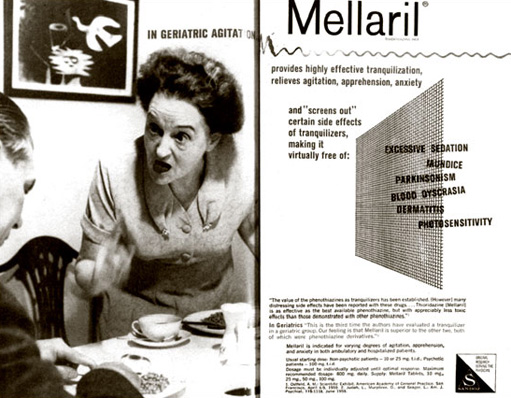3.2.1 A conflict of interest
One of the difficulties of the involvement of drug companies in the mental health field is that it produces a conflict of interest. To put it crudely, drug companies rely on a continuing supply of patients to keep them in business. This is not always congruent with people’s best interests, as you will see below. Although mental health services are intended to help people experiencing mental distress, they also have other driving forces. The market economy model of provision has encouraged the expansion of various aspects of mental health care, but has fuelled, in particular, the development and promotion of drugs to such an extent that it is now a huge business. The impact of the pharmaceutical industry is perhaps most pronounced in the USA, where the view that ‘psychiatry has been almost bought out by the drug companies’ (Mosher, 1999, p. 16) has been held for a number of years.
Concern about this conflict of interest is not new. In 1965, a journalist from the Washington Post wrote about the ‘therapeutic nightmare’ of psychiatric drugs being used to control ‘millions’ (Mintz, 1965). In 1974, the American Journal of Psychiatry raised concerns that ties between the American Psychiatric Association (APA) and pharmaceutical companies were going beyond the bounds of professionalism, compromising the organisation’s principles, and in some instances involving members in conflicts of interest (Breggin, 1993). By the 1980s a visible lobby within psychiatry was opposing the influence of the pharmaceutical companies. The main concerns were that:
Drug companies influenced individual psychiatrists’ prescribing decisions through heavy promotion at the conferences and in the academic journals they sponsored.
The dependence of university research departments on drug company funding might lead to bias in their results, particularly the results of studies evaluating the efficacy and safety of particular drugs.
More recently it can be argued that there is a growing medicalisation of aspects of everyday life, with conditions such as Attention Deficit Hyperactivity Disorder (ADHD) being treated with drugs. The use of Ritalin to treat children diagnosed with ADHD is widespread, with millions of children being prescribed this.

Whatever the cause, the trend of prescribing drugs opened the divide between the psychiatric professions and charities such as Mind that campaigned on behalf of people experiencing mental distress. The run-up to the Mental Health Act 1983 saw Mind and others arguing for stricter controls on the use of drugs for patients detained against their will. A decade later the pharmaceutical industry was rethinking its strategy for marketing to the NHS, following the creation of the internal market:
Glaxo Laboratories has an NHS Relations Unit which was set up in response to the major changes in the NHS structure […] Links are being established at managerial level in regional health authorities, district health authorities and family health services authorities.
Persuading professionals to prescribe a particular drug is vitally important to drug companies in terms of their ongoing profitability. For example, a single prescription of fluoxetine (Prozac) is £61.62 (NICE, 2019). Just how big is the market for antidepressants? Table 1 gives an indication of the market for antidepressants in England.
| Total items 2019 | Total items 2018 | Total items 2014 |
| 74,814,619 | 70,873,979 | 57,149,109 |
| Total cost 2019 | Total cost 2018 | Total cost 2014 |
| £201,729,576.00 | £202,526,719.66 | £265,008,698.97 |
As Table 1 illustrates, the ‘growth in the market’ for antidepressants has been considerable (i.e., there has been a 30.9% increase in ‘total items’ from 2014 to 2019). Such that antidepressants are now ranked as the ninth biggest expense in terms of medication purchases in England. By comparison, drugs used in diabetes care are ranked first, costing more than five times as much, at over £1 billion per year (NHS, 2020). But you will see that the total cost has decreased for antidepressants, which is not unusual given the ‘bargaining power’ of a large ‘customer’ like the NHS. The concerns associated with the growth in prescriptions of antidepressants is not new, as the following extract illustrates.
While health regulators are becoming increasingly anxious to control the use of Seroxat and other antidepressants, drug companies – equally anxious to gain as much income as possible from their medicinal cash cows – are trying to expand their uptake.
GlaxoSmithKline has made billions out of Seroxat and sees no reason why this should halt, it would appear. One of its internal marketing documents shows the company planned to double sales by targeting people who suffer from a widely recognised condition known as social phobias.

So, it can be extremely lucrative for a company to produce and successfully market a drug which is widely prescribed. Just how did this situation come about? In the next section you look at the history of the use of drugs for people experiencing mental distress by tracking the introduction of successive waves of medication, from early antipsychotics to more recently the use of selective seratonin re-uptake inhibitors (SSRIs).
